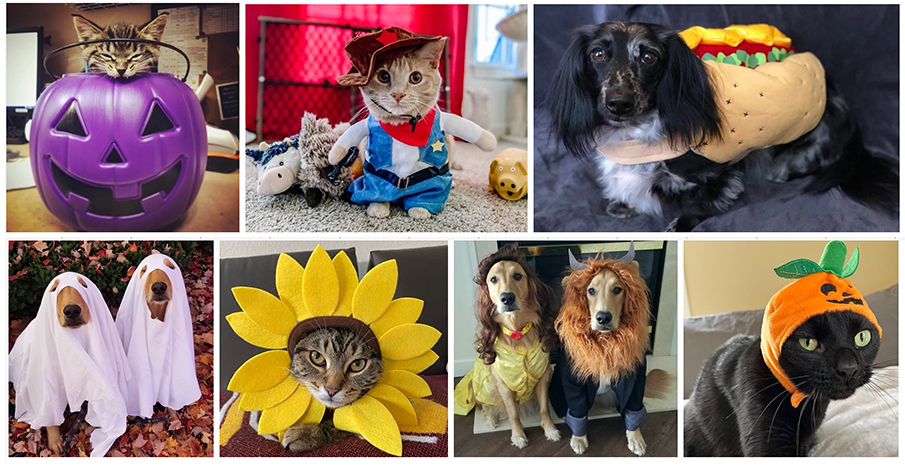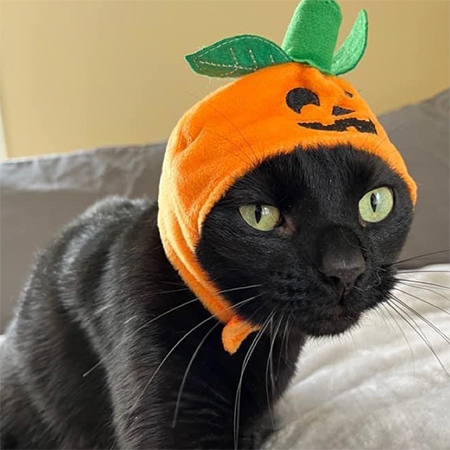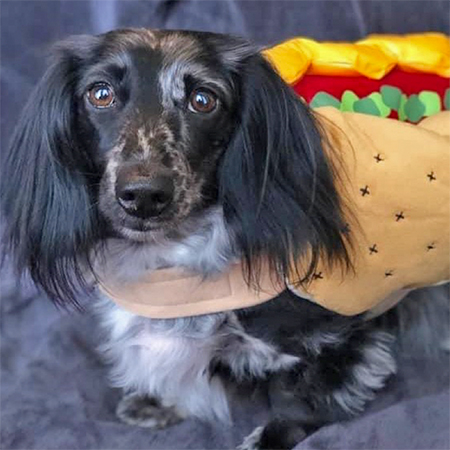Holiday Toxicities
Para leer el blog en español, haga clic aquí

Arriba se muestran mascotas de los estudiantes de la University of Illinois College of Veterinary Medicine.
The end of summer can leave individuals with mixed feelings. Yes, it means the end of pool parties and summer BBQs, but it’s the start of sweater weather, pumpkin spice, and the holiday season. And with that comes family gatherings and, most important, sweet treats and great food!
Halloween and Chocolate

First on our list is the all-time favorite holiday of most kids (and many adults), Halloween. Not only do you get to dress yourself and your pets up as silly characters, but you can eat all of the candy in the world and not be judged.
That comes with a few responsibilities though. As many of you might or might not know, chocolate can be highly toxic to dogs and cats when ingested. How exactly can chocolate affect your pet, you may ask? Chocolate contains a toxin called theobromine, which animals can be very sensitive to because they cannot metabolize it as well as people can.
The amount of theobromine varies by the type of chocolate consumed. For example, baking chocolate contains more theobromine than milk chocolate, which contains more theobromine than white chocolate. In mild cases you may see signs of stomach upset like vomiting, diarrhea, and inappetence. More severe signs include seizures, panting, restlessness, nervousness, and twitching.
Regardless of the amount and type of chocolate consumed by your pet, it is important to reach out to either your local veterinarian or animal poison control. These resources can guide you to your next step to assure your pet stays safe and healthy.
Xylitol
An ingredient that can be harmful and even lethal to pets is called xylitol. Xylitol is a sugar substitute that can be found in many sugar-free candies, gum, mints, vitamin gummies, baked goods, etc.
Animal poison control (fees apply)
can be reached at:ASPCA National Animal
Poison Control Center:
888-426 4435
Pet Poison Helpline: 800-213-6680
Fun fact: toothpaste can also contain xylitol due to its flavor and antibacterial properties. This sugar substitute can be lethal in as little as an hour if a large amount is consumed by your dog. Xylitol consumption can lead to hypoglycemia, which can cause vomiting, weakness, incoordination, tremors, and ultimately seizures. It can also lead to liver failure due to excessive insulin release.
When in doubt and your pet gets a hold of and consumes something that you suspect contains xylitol in it, it is important to note the amount ingested and take your pet along with the original packaging to your local veterinarian for further treatment. You can also contact poison control for further recommendations.
Holiday Feasts
Turkey, ham, stuffing, mashed potatoes, mac and cheese, and my all-time favorite tamales. Now we’re getting into the food-filled holidays, which are my personal favorites. With some of our favorite dishes come some ingredients that aren’t the best for our furry friends. Onions, garlic, and chives give many dishes the extra taste they need.

These savory additions can be harmful to our pets if ingested in a large quantity, even in dried, powdered, or cooked forms. The first signs that something is wrong are vomiting, diarrhea, gastroenteritis, and abdominal pain. More severe signs can take several days, but you can see increased heart and respiratory rate/effort, weakness, discolored urine, collapse, kidney damage, and even death.
These ill effects arise from oxidizing agents in onions and garlic, which cause oxidative hemolysis, meaning the destruction of red blood cells. We need red blood cells to carry oxygen throughout the body. If these blood cells are destroyed, vital organs cannot get enough oxygen. Early treatment can decrease the risk for serious effects, so if you suspect your pet has ingested something they shouldn’t have, contact your local veterinarian or poison control center.
It is also important to note that although ham off the bone is a delicacy during the holidays, feeding your domestic pet raw bones can be very dangerous. Bones can be a choking hazard and there is risk of injury if the bone splinters and becomes lodged or punctures your pet’s digestive tract. A foreign body surgery is a medical emergency!
High-Fat Foods
Now I won’t get into Christmas yet. I’ll save that for a later post. What I will mention is—yes, you guessed it!—pancreatitis.
What exactly is pancreatitis? Well, it’s inflammation of the pancreas. The pancreas is a small organ that is located just under the stomach and near the duodenum (a part of the small intestine). Its main job is to secrete digestive enzymes that help break down the nutrients in the foods we eat. It also secretes insulin and glucagon which help regulate the usage of those nutrients.
How do our pets get pancreatitis? A sudden meal high in fat is one of the classic presentations. Be sure to put all your holiday leftovers away in a place your pets cannot reach them, or they can get pancreatitis if they ingest a large amount of fatty foods. Other causes of pancreatitis include hormonal imbalances like diabetes mellitus and hypothyroidism, as well as certain drugs, pancreatic trauma, tumors, and obesity.
When there is inflammation of the pancreas, clinical signs that you may see in your pets include abdominal pain, loss of appetite, vomiting, diarrhea, and fever. If you suspect your pet might have gotten into food they shouldn’t have and notice any of the clinical signs mentioned above, reach out to your local veterinarian for further recommendations/treatment.
– Dr. Angelica Calderon
Toxicidades de Mascotas en Los Días Festivos
Llegar al final del verano puede tener personas con diferentes sentimientos. Sí, al terminal el verano significa el final de las fiestas en la piscina y las carnes asadas; sin embargo, es el comienzo del clima de suéter, pumpkin spice y los días festivos. Y con eso vienen las reuniones familiares y lo más importante, los dulces y la excelente comida!
Halloween y chocolate
Lo primero en nuestra lista es el día festivo favorito de la mayoría de los niños (y muchos adultos), Halloween. No solo puedes vestirte a ti y a tus mascotas como personajes chistosos, sino que también puedes comer todos los dulces del mundo y no ser juzgado.

Sin embargo, eso conlleva algunas responsabilidades. Como muchos de ustedes saben, el chocolate puede ser altamente tóxico para perros y gatos cuando se ingiere. Cómo puede afectar exactamente a su mascota? Bueno, la toxina del chocolate que puede afectar a perros y gatos se llama teobromina, a la que los animales pueden ser muy sensibles porque no pueden metabolizarla tan bien como las personas pueden.
La cantidad de teobromina varía según el tipo de chocolate consumido. Por ejemplo, el chocolate para hornear contiene más teobromina que el chocolate con leche, que contiene más teobromina que el chocolate blanco. En casos leves, puede ver signos de malestar estomacal como vómitos, diarrea e inapetencia. Los signos más graves incluyen convulsiones, jadeo, inquietud, nerviosismo y espasmos.
Independientemente de la cantidad y el tipo de chocolate que consuma su mascota, es importante que se comunique con su veterinario local o con el centro de control de envenenamiento, donde podrán guiarlo mejor hacia el siguiente paso para garantizar que su mascota se mantenga segura y saludable.
El xilitol
Un ingrediente que puede ser dañino e incluso letal para las mascotas se llama xilitol. El xilitol es un sustituto del azúcar que se puede encontrar en muchos dulces que dicen “sugar free”, goma de mascar/chicles, mentas, vitamínicas en goma, galletas, etc.
Centro Nacional de Control de
Envenenamiento Animal de ASPCA:888-426 4435
Línea de ayuda para
envenenamiento de mascotas:800-213-6680
Dato curioso: la pasta de dientes también puede contener xilitol debido a su sabor y propiedades antibacterianas. Este sustituto del azúcar puede ser letal en tan solo una hora si su perro consume una gran cantidad. El consumo de xilitol puede provocar hipoglucemia que puede causar vómitos, debilidad, falta de coordinación, temblores, y convulsiones. También puede provocar insuficiencia hepática debido a la liberación excesiva de insulina.
En caso de duda y su mascota se apodera y consume algo que sospecha que contiene xilitol, es importante anotar lacantidad ingerida y llevar a su mascota junto con el empaque original a su veterinario local para recibir tratamiento. También puede comunicarse con el control de envenenamiento para obtener más recomendaciones.
Los días festivos llenos de comida
Pavo, jamón, relleno, puré de papas, macarrones con queso y mi favorito, tamales. Ahora estamos entrando en los días festivos llenos de comida. Con nuestros platillos favoritos vienen algunos ingredientes que no son los mejores para nuestras mascotas. Las cebollas, el ajo y las pasas son unos ingredientes principales en muchos platillos que les dan el último toque de sabor a nuestra comida.
Estos pueden ser dañinos para nuestras mascotas si se ingieren en gran cantidad, incluso en forma seca, en polvo o cocida. Los primeros signos que puede notar son vómito, diarrea, gastroenteritis y dolor abdominal. Los signos más graves pueden tardar varios días, pero puede observar un aumento de la frecuencia/esfuerzo cardíaco y respiratorio, debilidad, orina descolorida, colapso, daño renal e incluso la muerte.
Esto sucede porque contienen agentes oxidantes que provocan hemólisis oxidativa, lo que significa destrucción de los glóbulos rojos. Necesitamos glóbulos rojos para transportar oxígeno por todo el cuerpo y, si se destruyen, los órganos vitales no pueden obtener suficiente oxígeno. El tratamiento temprano puede disminuir el riesgo de efectos graves, por lo que si sospecha que su mascota ha ingerido algo que no debería, comuníquese con su veterinario local o con el control de envenenamiento.
También es importante tomar en cuenta que aunque el jamón es plato muy común en los días festivos, alimentar a tu mascota con huesos crudos puede ser muy peligroso. Esto puede ser un peligro de asfixia y existe el riesgo de lesiones si el hueso se astilla y se atasca o perfora el tracto digestivo de su mascota. Una cirugía para remover un hueso del estómago o intestinos es una emergencia médica!
Otras comidas que debe evitar alimentar a sus mascotas
Una comida con mucha grasa
Ahora no entraré en Navidad todavía, lo guardaré para otro blog. Lo que mencionaré es, sí lo adivinaste, pancreatitis.
Puede preguntarse qué es exactamente la pancreatitis, bueno, es la inflamación del páncreas. El páncreas es un órgano pequeño que se encuentra justo debajo del estómago y cerca del duodeno (una parte del intestino delgado). Su trabajo principal es secretar enzimas digestivas que ayudan a descomponer los nutrientes de los alimentos que comemos. También secreta insulina y glucagón que ayudan a regular el uso de esos nutrientes.
Cómo contraen pancreatitis nuestras mascotas? Pues, una comida repentina con mucha grasa es una de las presentaciones clásicas. Asegúrese de guardar todas las sobras de las fiestas en un lugar donde sus mascotas no puedan alcanzarlas, o pueden contraer pancreatitis si ingieren una gran cantidad de alimentos grasos. Otras causas de pancreatitis incluyen desequilibrios hormonales como diabetes mellitus e hipotiroidismo, ciertos medicamentos, trauma pancreático, tumores y obesidad.
Cuando hay inflamación del páncreas, los signos clínicos que puede ver en sus mascotas incluyen dolor abdominal, pérdida de apetito, vómitos, diarrea y fiebre. Si sospecha que su mascota pudo haber ingerido alimentos que no debería y nota cualquiera de los signos clínicos mencionados anteriormente, comuníquese con su veterinario local para obtener más recomendaciones/tratamiento.
– Dr. Angelica Calderon
